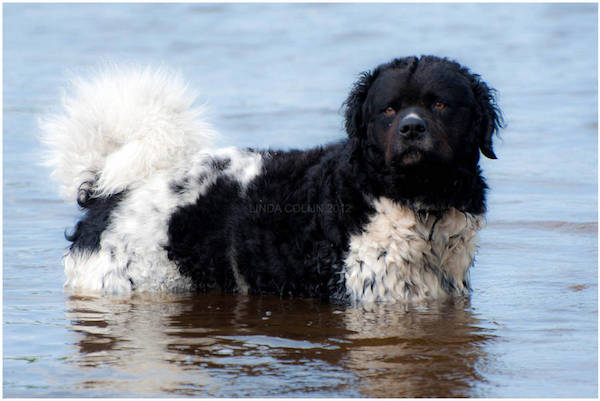
As with so many breeds, it’s not certain what the precise origins are of the Frisian Water Dog, better known as the Wetterhoun (Frisian meaning “water dog”), but it’s believed to have been developed in the Netherland’s historically isolated province of Fryslan at least 400 years ago. Speculation suggests that ancestors of the Wetterhoun came out of gypsy dogs that had dalliances with the indigenous Frisian dog. What resulted were tousle-haired dogs capable at retrieving waterfowl, hunting otters and polecats, and serving as watch dogs.
The breed nearly disappeared during World War II but was saved by Dutch dog fanciers of the Kynologenclub Friesland, especially J. Bos, T. van Dijk, B. de Graaf and W. Hoeksema. These people who took it upon themselves to recognize, preserve, and promote the Wetterhoun in 1938 as a distinct breed, no easy feat since Wetterhounen (the plural form) had been routinely bred with the Stabyhoun (another Dutch breed) in the early 1900s, and the uniqueness of each was at risk.
The process began by finding Wetterhounen that met the ideal image of the breed, then inviting their owners to bring their dogs to the first “inspection days” held in the town of Leeuwarden. Dogs with the right conformation were run through a hunting test that measured their field abilities, and accepted dogs were entered into an appendix of the Dutch Pedigree Register.
Up until the 1960s, these inspections and hunt tests were periodically held in and around Friesland resulting in several dozen Wetterhounen to be registered. At that point, the appendix was closed to further entries, and these early dogs became the standard group from which all future purebred Wetterhounen were derived. Databases are maintained by the Nederlandse Vereniging voor Stabij- en Wetterhounen, and the De Wetterhoun Vereniging Nederland.
The Wetterhoun is now recognized by the Fédération Cynologique Internationale in the Water Dogs section, and by the United Kennel Club which includes the breed in its Gundog Group. Wetterhounen are also recognized by a few minor registries and hunting clubs.
In the course of reading up on the Wetterhoun, we came across reference to the tail of the Wetterhoun being his “jewel” because he wears it in a fixed curl on or next to his back. It was such a descriptive phrase that we share it as the post title.
Thumbnail photo credit of Wetterhounen having fun by MJ Klaver <a href=”http://www.flickr.com/photos/24781126@N08/5401527804″>Grijns</a> via <a href=”http://photopin.com”>photopin</a> <a href=”https://creativecommons.org/licenses/by/2.0/”>(license)</a>
Large insert photo of a Dutch Wetterhoun in water by Linda Colijn/KonikPolski

